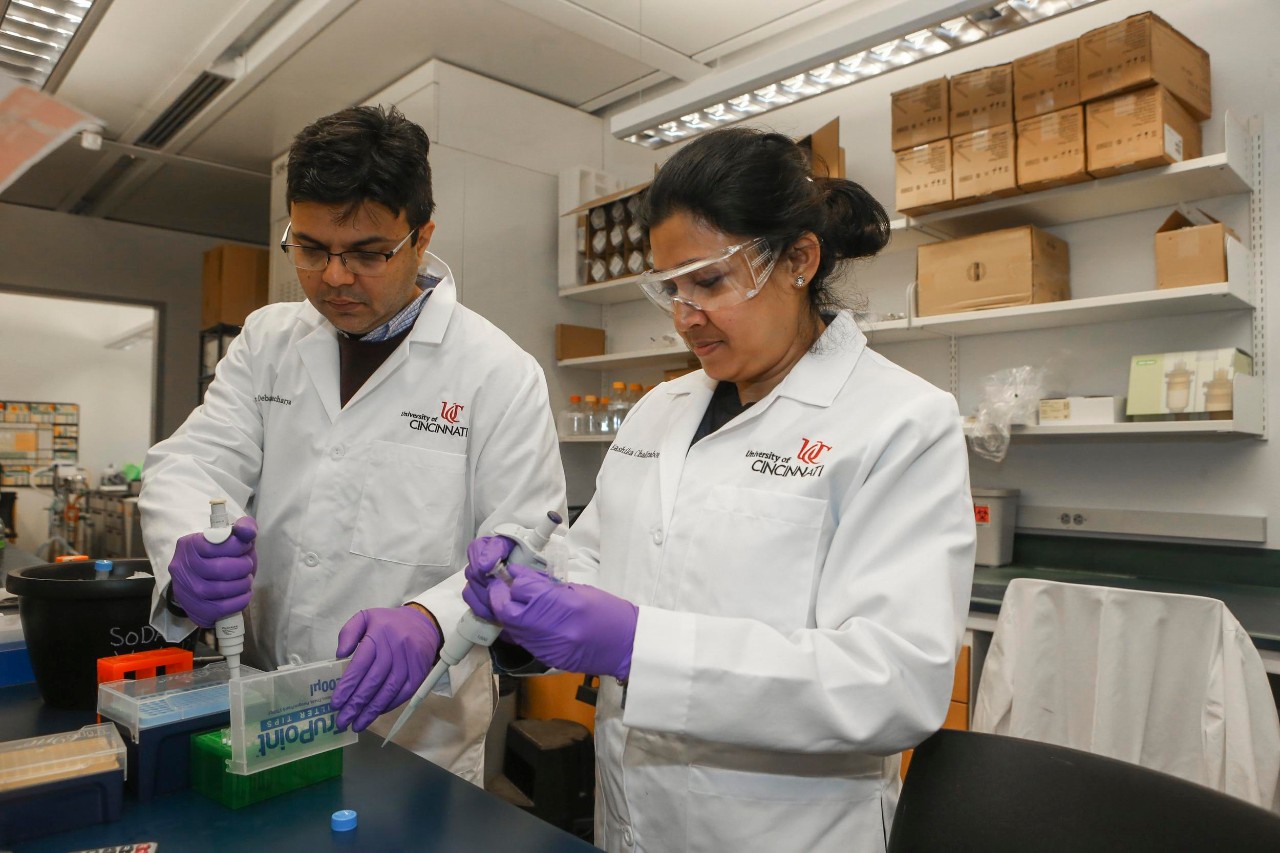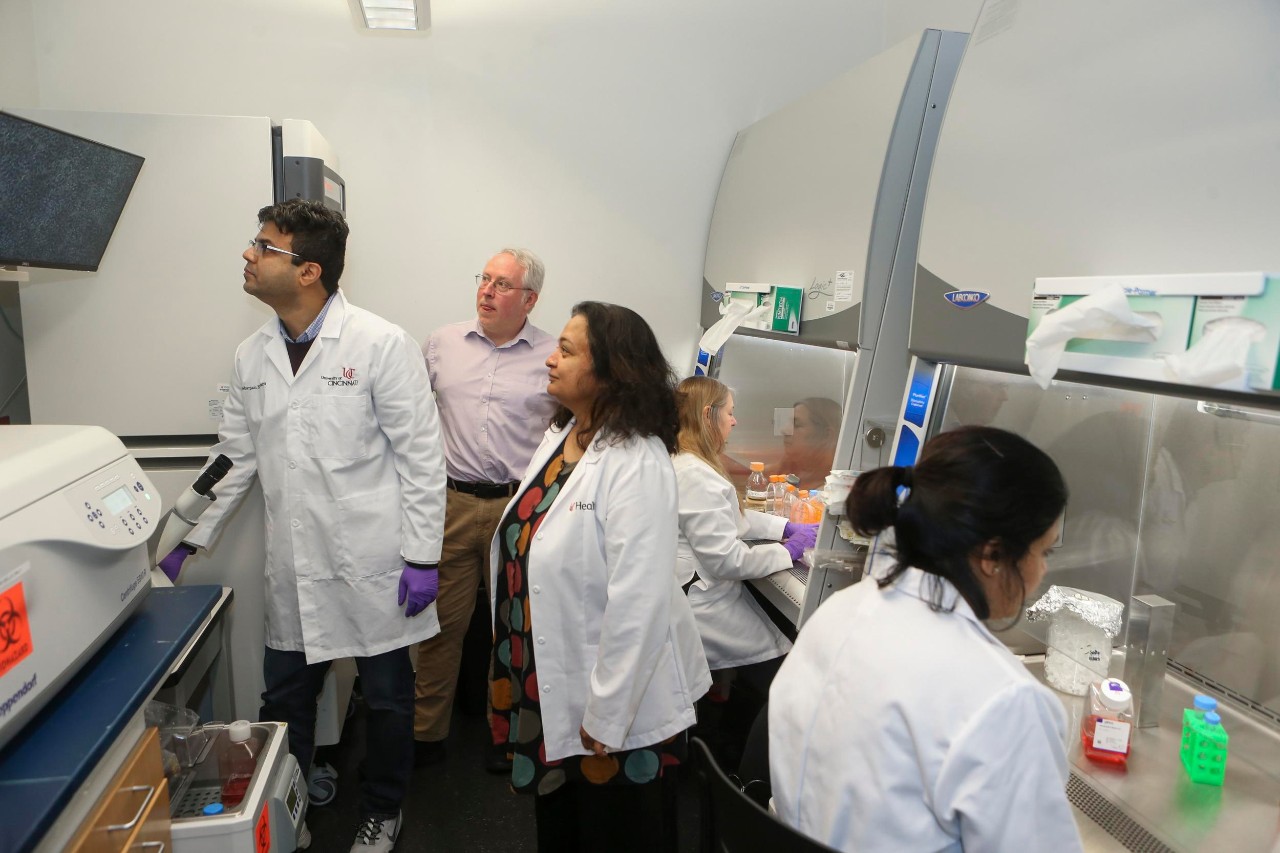Study: Drug improves effectiveness of radiation for lung cancer that has spread to the brain
In new research, a team led by University of Cincinnati researchers has identified a potential new way to make radiation more effective and improve outcomes for patients with lung cancer that has spread to the brain.
The study, led by first author Debanjan Bhattacharya, PhD, was recently published in the journal Cancers.
According to the American Cancer Society, lung cancer is the leading cause of cancer death in the United States, accounting for about one in five cancer deaths. Non-small cell lung cancer (NSCLC) is the most prevalent type of lung cancer, making up approximately 80% to 85% of all lung cancer cases.
Up to 40% of lung cancer patients develop brain metastases during the course of the disease, and these patients on average survive between eight and 10 months following diagnosis.
Current standard of care treatments for lung cancer that spreads to the brain include surgical removal and stereotactic brain radiosurgery (using precisely focused radiation beams to treat tumors) as well as whole brain irradiation in patients with more than 10 metastatic brain lesions.
“Lung cancer brain metastasis is usually incurable, and whole brain radiation treatment is palliative, as radiation limits therapy due to toxicity,” said Bhattacharya, research instructor in the Department of Neurology and Rehabilitation Medicine in UC’s College of Medicine. “Managing potential side effects and overcoming resistance to radiation are major challenges when treating brain metastases from lung cancer. This highlights the importance of new treatments which are less toxic and can improve the efficacy of radiation therapy, are less expensive, and can improve the quality of life in patients.”
Debanjan Bhattacharya, left, is first author of the study published in the journal Cancers. Photo/Joseph Fuqua II/UC Marketing + Brand.
Bhattacharya and his colleagues at UC focused on AM-101, a synthetic analog, meaning it has a close resemblance to the original compound, in the class of benzodiazepine drugs. It was first developed by James Cook, a medicinal chemist at the University of Wisconsin-Milwaukee. Prior to this study, AM-101’s effect in non-small cell lung cancer was unknown.
AM-101 is a particularly useful drug in the context of brain metastases in NSCLC, Bhattacharya said, as benzodiazepines are known to be able to pass through the blood-brain barrier that protects the brain from potential harmful invaders that can also block some drugs from reaching their target in the brain.
The team found AM-101 activated GABA(A) receptors located in the NSCLC cells and lung cancer brain metastatic cells. This activation triggers the “self-eating” process of autophagy where the cell recycles and degrades unwanted cellular parts.
Specifically, the study showed that activating GABA(A) receptors increases the expression and clustering of GABARAP and Nix (an autophagy receptor), which boosts the autophagy process in lung cancer cells. This enhanced "self-eating" process of autophagy makes lung cancer cells more sensitive to radiation treatment.
Using animal models of lung cancer brain metastases, the team found AM-101 makes radiation treatment more effective and significantly improves survival. Additionally, the drug was found to slow down the growth of the primary NSCLC cells and brain metastases.
In addition to making radiation more effective, adding AM-101 to radiation treatments could allow for lower radiation doses, which could reduce side effects and toxicity for patients, Bhattacharya said. The team is now working toward opening Phase 1 clinical trials testing the combination of AM-101 and radiation both in lung cancer within the lungs and lung cancer that has spread to the brain.
Bhattacharya, far left, credits the mentorship of former UC faculty members Daniel Pomeranz Krummel, second from left, and Soma Sengupta in helping move the research forward. Photo/Joseph Fuqua II/UC Marketing + Brand.
Bhattacharya began this research while working in the lab of former UC researchers Soma Sengupta, MD, PhD, and Daniel Pomeranz Krummel, PhD, who are now at the University of North Carolina at Chapel Hill. Bhattacharya credits their mentorship and the collaboration with other experts within UC and across multiple academic research institutions in the United States.
Bhattacharya also emphasizes the role of shared university research resources that helped the study move forward. He dedicates this work to his father, who died in 2021 while he was in the early phases of the research.
“The entire work, along with revision experiments, was done at the University of Cincinnati, and this reflects the strong collaborative effort between multiple teams. I am grateful to the Department of Neurology and Rehabilitation Medicine for the overall support in completion of this study,” he said. “My father's passing motivated me to work harder to complete this project, as he had known about my research and wanted to see me succeed.”
Impact Lives Here
The University of Cincinnati is leading public urban universities into a new era of innovation and impact. Our faculty, staff and students are saving lives, changing outcomes and bending the future in our city's direction. Next Lives Here.
Featured photo at top of Bhattacharya working in the lab. Photo/Joseph Fuqua II/UC Marketing + Brand.
Latest UC News
- Thinking globally: Developing an international nurse anesthesia partnershipThe desire to establish an international partnership has long been a goal of the University of Cincinnati (UC) College of Nursing Nurse Anesthesia DAs plans were placed on hold for a few years due to the COVID pandemic, virtual communications between the two institutions continued and, last April, six UC nursing students and two faculty members traveled to Paris, France, for a long-planned week of networking and education alongside IFITS students.octor of Nursing Practice program.
- Sculptor of Pete Rose statue talks about hit king's legacySpectrum News talks to University of Cincinnati graduate Tom Tsuchiya about his sculpture of baseball legend Pete Rose. The sculpture outside Great American Ball Park has become a memorial for Cincinnatians wishing to pay respects to the late World Series champion.
- Black girls face more frequent discipline in school, new report showsA new study from the U.S. Government Accountability Office shows Black girls face more frequent and severe discipline in public schools than girls from other racial backgrounds.
- Stroke symptoms for women to look out forThe University of Cincinnati's Pooja Khatri was featured in an MSN and Huffington Post UK article discussing how symptoms of stroke can look different for women.
- UC student leaders take a stand against gender-based violence with revival of music eventAfter a decade hiatus, the Clifton Heights Music Festival returns with more than 40 music acts set to perform Friday and Saturday, Oct. 4-5. UC students leaders have worked closely with presenter Far-i-Rome Creative to revive the festival.
- UC College of Allied Health Sciences receives top diversity awardThe University of Cincinnati's College of Allied Health Sciences (CAHS) has earned the 2024 Health Professions Higher Education Excellence in Diversity (HEED) Award from "Insight Into Diversity" magazine for the sixth consecutive year. This prestigious recognition highlights CAHS's commitment to fostering diversity, equity and inclusion (DEI) within its academic programs, while preparing a diverse and inclusive health care workforce for the future.















